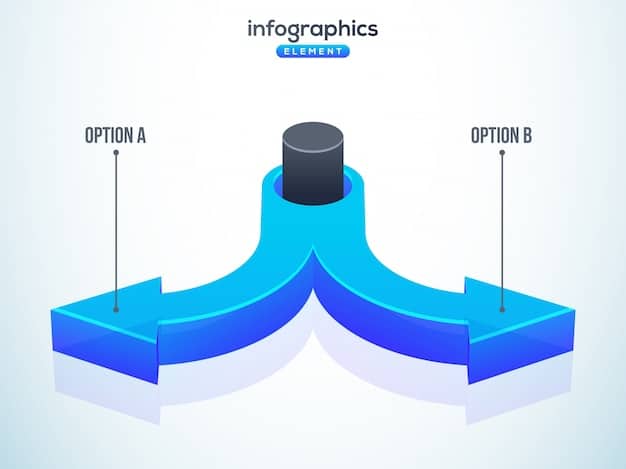Online Education ROI: Costs & Outcomes vs. On-Campus Programs

Analyzing the return on investment for online education reveals a compelling case for its cost-effectiveness and comparable, often superior, outcomes when critically compared to traditional on-campus programs.
The landscape of higher education is constantly evolving, with more students exploring alternatives to the conventional university experience. As financial pressures mount and technology advances, the question of the ROI of Online Education: Comparing Costs and Outcomes to Traditional On-Campus Programs becomes increasingly pertinent for prospective students, parents, and policymakers alike. Understanding this return on investment requires a nuanced look beyond mere tuition fees, delving into a holistic assessment of economic, academic, and personal benefits.
Understanding the Financial Landscape of Higher Education
The financial commitment to higher education is a significant hurdle for many. Traditional on-campus programs often entail a labyrinth of expenses extending far beyond tuition, while online education presents a seemingly streamlined, albeit complex, cost structure. A clear understanding of these financial dynamics is crucial for discerning the true return on investment for each educational pathway.
On-campus programs traditionally involve tuition and fees, which can vary wildly between public and private institutions. However, the costs don’t stop there. Room and board, transportation, textbooks, personal expenses, and the opportunity cost of foregone earnings due to full-time study accumulate rapidly. These ancillary costs often represent a substantial portion of the total financial outlay, sometimes even surpassing tuition itself. This comprehensive financial burden can lead to significant student loan debt, impacting graduates’ financial freedom for years.
Hidden Costs in Traditional Higher Education
Many students and families overlook the myriad of indirect costs associated with living on campus. These can add tens of thousands of dollars to the overall expense.
- Housing and utilities: Rent, electricity, internet, and often mandatory meal plans.
- Transportation: Fuel, car maintenance, or public transport passes for commutes or trips home.
- Personal expenses: Laundry, entertainment, supplies, and unexpected emergencies.
- Opportunity cost: The income potential lost by not working full-time or by taking lower-paying, part-time jobs while studying.
Online education, in contrast, often significantly reduces or eliminates many of these ancillary expenses. While tuition exists, students typically reside at home, mitigating costs associated with room and board. Commuting expenses are nil, and the flexibility of online learning can allow students to maintain full-time or part-time employment, thereby reducing the opportunity cost. This direct financial advantage positions online education as a potentially more accessible and less debt-inducing option for many.
Ultimately, evaluating the financial ROI between online and on-campus education necessitates a holistic calculation. It’s not just about comparing published tuition rates, but about weighing the total cost of attendance against the potential earnings and career advancement opportunities each pathway offers. The decision often boils down to a trade-off between perceived prestige, campus experience, and tangible financial savings.
Cost Comparison: Tuition, Fees, and Beyond
When evaluating the financial viability of online versus traditional on-campus education, a superficial glance at tuition fees can be misleading. A deeper dive into the full spectrum of costs reveals how online learning often presents a more economically advantageous path, extending beyond the headline price tag to encompass a range of expenses that impact the overall educational investment.
Traditional on-campus programs are inherently associated with significant fixed and variable costs. Tuition, while substantial, is merely the tip of the iceberg. Fees for campus activities, technology, health services, and specific course materials further inflate the bill. More profoundly, the non-educational living expenses form a large, often underestimated, part of the financial burden. These include residential costs, such as dorm fees and meal plans, which can easily amount to tens of thousands of dollars annually. When you factor in transportation, personal supplies, and the occasional leisure activity typical of student life, the cumulative cost can be daunting. The need to move closer to a physical campus can also trigger additional expenses like new furniture or storage.
Online programs, by their very nature, alleviate many of these expenses. Students undertaking online courses typically study from their current residence, thereby eliminating room and board charges. The need for daily commuting is removed, cutting transportation costs significantly. While some online programs may still have technology or administrative fees, they are generally less extensive than those found in a brick-and-mortar institution. The inherent flexibility of online learning also allows many students to maintain part-time or even full-time employment, directly offsetting some of their education costs and reducing the reliance on student loans. This maintained income stream during study is a critical component of the financial ROI.
The True Cost of Campus Life
Beyond direct university charges, the lifestyle associated with traditional university attendance creates a ripple effect of expenses.
- Social and recreational activities: Sporting events, concerts, club memberships, and spontaneous outings.
- Food and dining: Beyond meal plans, students often spend on eat-out meals, coffee, and snacks.
- Textbooks and supplies: While both formats require these, physical books can sometimes be more expensive or inconvenient to acquire for off-campus living.
- Relocation expenses: Moving costs, setting up a new living space, and potential summer storage.
It is not uncommon for the total cost of attendance for an on-campus student to be double or triple the published tuition fee, once all living and incidental expenses are factored in. For online students, the costs are much more concentrated on tuition and direct course materials, with a significantly lower overhead. This disparity in overall cost is perhaps the most compelling argument for the financial ROI of online education, making quality higher education accessible to a broader demographic without accumulating prohibitive debt. The savings realized in non-academic expenses can be redirected towards textbooks, technology, or even invested, further enhancing the long-term financial return.
Academic Outcomes and Quality: Debunking Myths
For years, a pervasive myth lingered: online education, while convenient, inherently compromised academic rigor and quality. However, as digital learning platforms have matured and pedagogical approaches adapted, this narrative has been increasingly debunked. Modern online programs, especially those from reputable institutions, often mirror or even surpass the academic outcomes of their traditional counterparts, challenging preconceived notions about digital learning.
The foundation of quality online education lies in its instructional design. Far from simply transferring lectures to a video format, effective online courses employ sophisticated learning management systems, interactive multimedia content, virtual labs, and collaborative tools. They often feature asynchronous learning, allowing students to engage with material at their own pace, and synchronous sessions, fostering real-time interaction. This blend caters to diverse learning styles and provides flexibility, which can lead to deeper engagement for some students. Faculty engaged in online teaching are increasingly trained in digital pedagogy, ensuring that the course content is not just delivered but effectively learned.
Addressing Concerns About Quality
Common criticisms of online learning often stem from outdated perspectives or experiences with poorly executed programs.
- Lack of interaction: Modern online courses use discussion boards, video conferencing, and group projects to ensure robust peer and instructor interaction.
- Lower academic standards: Accredited online programs adhere to the same rigorous academic standards as their on-campus equivalents, often taught by the same faculty.
- Cheating concerns: Sophisticated proctoring software and diverse assessment methods are employed to maintain academic integrity.
- Limited resources: Online libraries, virtual tutors, career services, and technical support are now standard offerings for online students.
Furthermore, the outcomes for online graduates often prove comparable to — or, in some instances, exceed — those of their on-campus peers. Studies have shown similar graduation rates, post-graduation employment rates, and career advancement trajectories. The self-discipline, time management, and technological proficiency honed through online learning are highly valued skills in today’s workforce. The ability to balance studies with work or family commitments also means online graduates often enter the workforce with practical experience already under their belt, giving them an edge.
The quality of an educational experience, whether online or on-campus, ultimately depends on several factors: the institution’s reputation, the program’s accreditation, the faculty’s expertise, and the student’s commitment. Online education has proven its capacity to deliver high-quality academic outcomes, providing a legitimate and often preferable alternative for those seeking flexibility and value without compromising educational excellence. The evolving digital landscape continues to drive innovation in online pedagogy, further solidifying its academic standing.
Career Prospects and Employability: Impact of Modality
One of the most pressing questions for any student considering a degree program revolves around its impact on career prospects and employability. Historically, there was a bias favoring traditional degrees, but as online education has gained widespread acceptance and quality, the perceived disparity in employer recognition is rapidly diminishing. In fact, for many roles and industries, the modality of learning has become largely irrelevant, while the demonstrated skills and degree relevancy take center stage.
Employers are increasingly focused on what a candidate can do, not necessarily where or how they acquired their knowledge. The accreditation of the institution, the rigor of the curriculum, and the practical skills imparted by the program hold more weight than whether classes were attended in person or virtually. Many reputable universities, including Ivy League institutions, now offer robust online degree programs, meaning that an online degree often carries the same institutional prestige as an on-campus one. Recruiters are more interested in a candidate’s portfolio, practical experience, problem-solving abilities, and soft skills developed during their studies.
Advantages for Online Graduates
Online learning itself can cultivate highly desirable traits for the modern workforce.
- Self-discipline and time management: Essential for managing independent study and deadlines.
- Digital literacy: Proficiency with various online tools and collaborative platforms.
- Adaptability: Comfort with learning in dynamic, evolving environments.
- Networking: Online students often connect globally, building a diverse professional network.
Furthermore, many online students are already working professionals seeking to upskill or reskill. This means they often graduate with not only a degree but also concurrent professional experience, offering a significant advantage in the job market. Their ability to balance academic demands with professional responsibilities demonstrates exceptional drive and organizational skills—qualities highly sought after by employers. Unlike traditional students who might graduate with theoretical knowledge, online learners often apply concepts in real-time within existing jobs, bridging the gap between theory and practice effectively.
While some highly specialized fields might still prefer a traditional degree due to practical elements like lab access or studio work, even these areas are seeing hybrid models emerge. For the vast majority of professions, particularly those in business, technology, healthcare administration, and the humanities, an online degree from a respected institution is now viewed as equally valid and valuable. The emphasis has shifted from the “where” and “how” to the “what”—what skills and knowledge does the graduate possess, and how can they contribute to the organization? This evolving perception solidifies the strong career ROI of online education.

Student Experience and Engagement: A New Perspective
The student experience in higher education traditionally conjures images of bustling campuses, extracurricular activities, and face-to-face interactions. While these elements are undeniably valuable, the online student experience has evolved far beyond solitary screen time, offering unique avenues for engagement, community building, and personalized learning that cater to a different, yet equally enriching, set of needs.
Online learning platforms have become increasingly sophisticated, fostering dynamic virtual environments that promote interaction among peers and instructors. Discussion forums are no longer static text boxes but vibrant intellectual spaces where students debate ideas, share insights, and collaborate on projects asynchronously. Live virtual classes, video conferencing tools, and group chat features facilitate synchronous interaction, mimicking the real-time discussions of a traditional classroom. Many institutions also offer virtual office hours, allowing for personalized one-on-one time with professors. The perceived isolation of online learning is often overstated, particularly in well-designed programs that prioritize community.
Building Community in a Virtual Space
Online universities are actively creating opportunities for students to connect and engage beyond the structured curriculum.
- Virtual clubs and organizations: Interest-based groups, student government, and professional associations.
- Online mentorship programs: Connecting students with alumni or industry professionals.
- Regional meetups: Some programs organize optional in-person gatherings for local students.
- Social media groups: Informal spaces for peer support, study groups, and shared experiences.
Moreover, the flexibility inherent in online education contributes significantly to the student experience. Adult learners, working professionals, and those with family commitments often find that online learning allows them to pursue higher education without disrupting their lives. This ability to integrate studies into an existing schedule reduces stress and enhances motivation, leading to a more positive overall experience. They can apply new knowledge directly to their current work, making the learning immediately relevant and reinforcing comprehension.
While online learning may lack the spontaneous social interactions of a physical campus, it compensates with intentional design for engagement and unparalleled flexibility. It empowers a diverse range of learners who might otherwise be excluded from higher education due to geographical constraints, work schedules, or personal responsibilities. The “experience” of online education is not a lesser one, but a different one—one that emphasizes self-directed learning, digital collaboration, and a personalized approach, proving that a rich educational journey can thrive outside traditional campus boundaries.
Return on Investment Frameworks: Quantifying Value
To truly assess the ROI of online education versus traditional on-campus programs, it’s essential to move beyond anecdotal evidence and apply robust analytical frameworks. Quantifying value involves more than just comparing initial tuition costs; it requires a critical examination of economic gains, career trajectory post-graduation, and the long-term financial implications of each educational pathway. Developing a comprehensive ROI framework helps prospective students make informed decisions, considering both immediate and future benefits.
The primary component of the economic ROI framework is the net present value (NPV) of a degree. This considers the total cost of education (tuition, fees, living expenses, and foregone earnings) against the projected increase in lifetime earnings attributable to the degree. For online education, the reduction in living expenses and the ability to maintain employment during study significantly lower the “cost” side of the equation, often resulting in a higher NPV earlier in the graduate’s career. While the earnings boost from a degree might be similar across modalities for comparable programs, the lower initial outlay of online education means the breakeven point and subsequent positive return are often achieved faster.
Key Metrics for ROI Calculation
When evaluating the return, several factors contribute to a comprehensive picture.
- Earnings premium: The difference in average salary between degree holders and non-degree holders.
- Time to recoup investment: How long it takes to earn back the costs of education through increased salary.
- Debt-to-income ratio: Post-graduation debt relative to starting salary, impacting financial freedom.
- Career advancement: Promotions, leadership roles, and increased responsibilities enabled by the degree.
Beyond the purely financial, an expanded ROI framework considers non-pecuniary benefits. These include improved job satisfaction, enhanced critical thinking skills, expanded professional networks, and greater overall life satisfaction. While harder to quantify monetarily, these contribute significantly to an individual’s overall well-being and long-term success. Online learning often uniquely contributes to these by fostering self-discipline, digital proficiency, and a global perspective through interaction with diverse learners.
The value proposition of online education is increasingly compelling when viewed through a comprehensive ROI lens. It offers a path to acquire valuable skills and credentials with a potentially lower financial burden, faster payback period, and comparable career outcomes. For many, particularly working adults, the flexibility to continue earning while learning means the “foregone earnings” component of the cost is significantly reduced or eliminated, tilting the ROI heavily in favor of the online model. It’s a strategic investment that maximizes educational gain while minimizing financial exposure.
Future Trends and the Evolving Definition of ROI
The future of higher education is undeniably digital. As technology continues its rapid advancement and societal needs shift, the definition of “Return on Investment” in education is evolving beyond traditional metrics, placing a greater emphasis on adaptability, lifelong learning, and the economic agility fostered by flexible educational models. Online education is uniquely positioned at the forefront of these transformations, promising even greater ROI in the coming decades.
Artificial intelligence, immersive technologies like virtual and augmented reality, and personalized learning analytics are poised to revolutionize online education. AI-driven tutors can provide tailored support, VR simulations offer hands-on experiences without physical labs, and data analytics can optimize learning paths for individual students. These innovations will not only enhance the academic quality and engagement of online programs but also make them more efficient and cost-effective, thus boosting their ROI further. The ability to update curricula rapidly to reflect industry changes is also a distinct advantage of online formats, ensuring graduates’ skills remain current and in demand.
The Broader Definition of Educational ROI
Looking ahead, ROI will encompass more than just salary increases.
- Agility and continuous learning: The ability to quickly acquire new skills throughout one’s career.
- Global networking: Connections with diverse peers and faculty worldwide.
- Mental well-being: Flexibility reducing stress and improving work-life balance.
- Social impact: Contribution to community and ethical leadership.
The concept of “lifelong learning” is gaining paramount importance in a volatile job market. Online education, with its inherent flexibility and modularity, is the ideal vehicle for continuous upskilling and reskilling. Micro-credentials, bootcamps, and specialized online courses allow individuals to acquire specific, in-demand skills quickly without committing to full degree programs, offering a high-speed, high-ROI approach to career development. This modular approach to learning means that the “return” is not just a one-time lump sum after graduation, but a continuous stream of value derived from ongoing educational investments.
As traditional institutions increasingly integrate online components and hybrid models become the norm, the distinction between “online” and “on-campus” education will blur further. The focus will shift entirely to the quality of learning outcomes, the relevance of skills acquired, and the accessibility of education. The ROI of online education already stands strong, built on cost-effectiveness, comparable academic and career outcomes, and unparalleled flexibility. In the future, its capacity for innovation and adaptation will cement its status as a superior investment for a dynamic world, redefine what value means in higher education, and fundamentally shape the future workforce.

| Key Aspect | Brief Comparison & Impact on ROI |
|---|---|
| 💸 Cost Structure | Online: Lower overall cost due to reduced living expenses & opportunity cost. Traditional: Higher total cost with room, board, and hidden fees. |
| 🎓 Academic Quality | Online: Comparable rigor and outcomes from accredited institutions, often with innovative pedagogy. Traditional: Established models, but not inherently superior. |
| 📈 Career Prospects | Employer perception evolving; focus on skills and accreditation, not modality. Online students often bring concurrent work experience. |
| 🔄 Flexibility & Lifelong Learning | Online: High adaptability, ideal for working professionals and continuous skill development. Traditional: Less flexible, typically full-time commitment required. |
Frequently Asked Questions About Online vs. Traditional Education ROI
▼
Yes, increasingly so. Employer perception has shifted, placing more emphasis on the institution’s accreditation, the program’s rigor, and the skills acquired, rather than the delivery method. Many reputable universities offer online programs, and their degrees carry the same weight as on-campus ones. Practical experience gained during online study can also be a significant advantage.
▼
Savings vary but can be substantial. While tuition might be similar or slightly lower, the biggest savings come from eliminating or drastically reducing non-tuition costs like room and board, transportation, and campus fees. The ability to maintain current employment also reduces “opportunity cost” significantly, contributing to overall financial savings and a better ROI.
▼
Many institutions offering online programs provide comprehensive virtual career services, including resume workshops, interview coaching, and job boards. Networking opportunities are also fostered through online discussion forums, virtual professional groups, and alumni networks. While different from in-person, these avenues can be equally effective and often offer broader reach.
▼
Online learning is ideal for self-disciplined individuals who thrive with flexibility and independent study. It requires strong time management and motivation. While suited for many, those who prefer highly structured, in-person social environments or hands-on experimental learning might find traditional settings more appealing. However, modern online programs incorporate various interactive elements.
▼
Accreditation is crucial for an online degree’s ROI. A degree from a regionally or nationally accredited institution ensures quality, employer recognition, and eligibility for financial aid. Without accreditation, the degree’s value and its return on investment diminish significantly, as employers may not recognize it and further education could be difficult to pursue.
Conclusion: Strategic Investment in a Changing Educational Landscape
The comprehensive analysis of “The ROI of Online Education: Comparing Costs and Outcomes to Traditional On-Campus Programs” reveals a compelling narrative favoring online learning as a strategic and often superior investment in today’s dynamic educational landscape. Far from being a mere alternative, online education has matured into a robust, high-quality pathway offering significant financial advantages without compromising academic rigor or career prospects. Its lower overall cost, flexibility for diverse learners, and cultivation of highly valued 21st-century skills contribute to a powerful return on investment. As institutions continue to innovate and technological advancements reshape learning, the value proposition of online education will only strengthen, making it an increasingly attractive choice for those seeking efficient, effective, and future-proof higher education opportunities.





